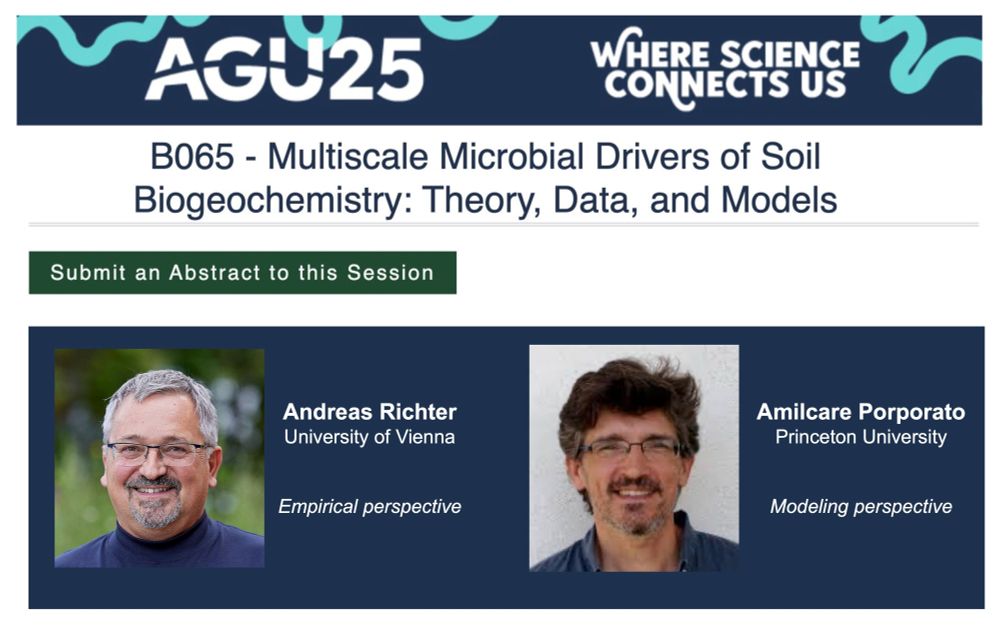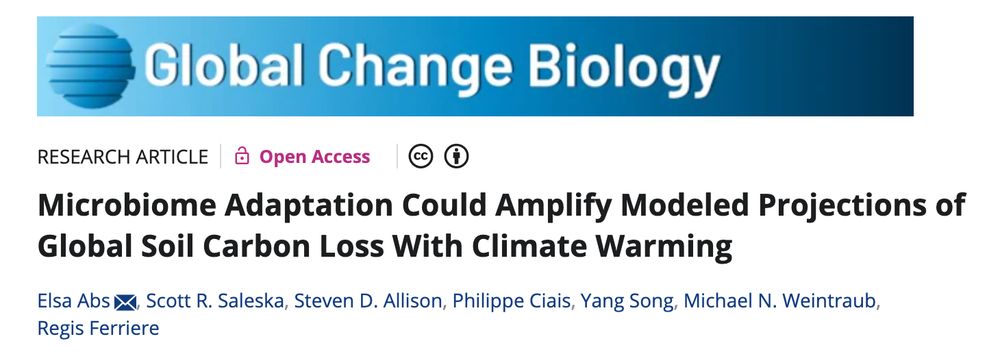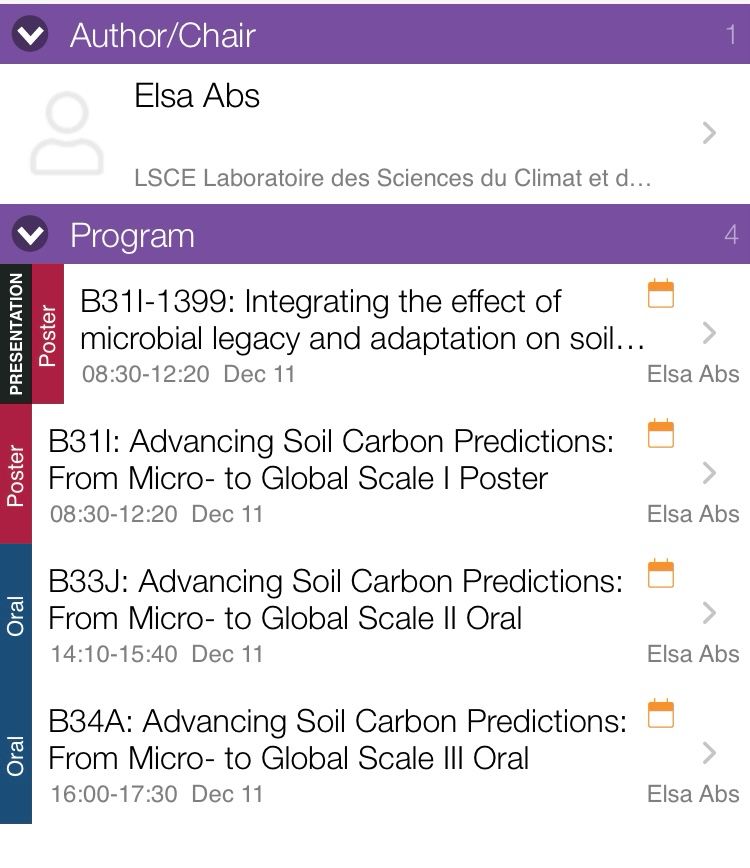
https://www.elsaabs.com/
Check out our session co-organized with @kristenobacter.bsky.social (UMass), Ulas Karaoz and Nicola Falco (Berkeley Lab).
In-person invited speakers: @andreasrichter.bsky.social (U of Vienna) & Amilcare Porporato (Princeton) 🤩

Check out our session co-organized with @kristenobacter.bsky.social (UMass), Ulas Karaoz and Nicola Falco (Berkeley Lab).
In-person invited speakers: @andreasrichter.bsky.social (U of Vienna) & Amilcare Porporato (Princeton) 🤩
We wondered if we could replace eco-evolution with a constant correction. Answer: no. Its effect is uneven—negligible in warm regions, but up to 2× more soil C loss in cold ones. Why? Optimal enzyme allocation responds nonlinearly. (6/7)

We wondered if we could replace eco-evolution with a constant correction. Answer: no. Its effect is uneven—negligible in warm regions, but up to 2× more soil C loss in cold ones. Why? Optimal enzyme allocation responds nonlinearly. (6/7)
We thought that microbial adaptation would buffer warming-induced soil C loss. But because it amplifies enzyme production (as shown above), we found that adaptation aggravates the loss—by x1.8 globally. (5/7)

We thought that microbial adaptation would buffer warming-induced soil C loss. But because it amplifies enzyme production (as shown above), we found that adaptation aggravates the loss—by x1.8 globally. (5/7)
We found that in hostile environments (e.g. high mortality, slow uptake), selection favors direct investment in biomass over the riskier strategy of enzyme production. Since warming mainly increases uptake rate, we predicted it would favor stronger enzyme producers. (3/7)

We found that in hostile environments (e.g. high mortality, slow uptake), selection favors direct investment in biomass over the riskier strategy of enzyme production. Since warming mainly increases uptake rate, we predicted it would favor stronger enzyme producers. (3/7)
We added a trade-off to a classic microbe-soil C model and used adaptive dynamics to evolve enzyme allocation. To prevent freeloaders from taking over, we included implicit spatial structure. Bonus: enzyme production emerges—it’s no longer a free parameter. (2/7)

We added a trade-off to a classic microbe-soil C model and used adaptive dynamics to evolve enzyme allocation. To prevent freeloaders from taking over, we included implicit spatial structure. Bonus: enzyme production emerges—it’s no longer a free parameter. (2/7)
doi.org/10.1111/gcb....
We built the first soil carbon model that includes microbial eco-evolution using game theory — and found that adaptation could nearly double global soil carbon loss by 2100. Here is how👇(1/7)

doi.org/10.1111/gcb....
We built the first soil carbon model that includes microbial eco-evolution using game theory — and found that adaptation could nearly double global soil carbon loss by 2100. Here is how👇(1/7)
We wondered if we could replace eco-evolution with a constant correction. Answer: no. Its effect is uneven—negligible in warm regions, but up to 2× more soil C loss in cold ones. Why? Optimal enzyme allocation responds nonlinearly. (6/7)

We wondered if we could replace eco-evolution with a constant correction. Answer: no. Its effect is uneven—negligible in warm regions, but up to 2× more soil C loss in cold ones. Why? Optimal enzyme allocation responds nonlinearly. (6/7)
We thought that microbial adaptation would buffer warming-induced soil C loss. But because it amplifies enzyme production (as shown above), we found that adaptation aggravates the loss—by x1.8 globally. (5/7)

We thought that microbial adaptation would buffer warming-induced soil C loss. But because it amplifies enzyme production (as shown above), we found that adaptation aggravates the loss—by x1.8 globally. (5/7)
We found that in hostile environments (e.g. high mortality, slow uptake), selection favors direct investment in biomass over the riskier strategy of enzyme production. Since warming mainly increases uptake rate, we predicted it would favor stronger enzyme producers. (3/7)

We found that in hostile environments (e.g. high mortality, slow uptake), selection favors direct investment in biomass over the riskier strategy of enzyme production. Since warming mainly increases uptake rate, we predicted it would favor stronger enzyme producers. (3/7)
We added a trade-off to a classic microbe-soil C model and used adaptive dynamics to evolve enzyme allocation. To prevent freeloaders from taking over, we included implicit spatial structure. Bonus: enzyme production emerges—it’s no longer a free parameter. (2/7)

We added a trade-off to a classic microbe-soil C model and used adaptive dynamics to evolve enzyme allocation. To prevent freeloaders from taking over, we included implicit spatial structure. Bonus: enzyme production emerges—it’s no longer a free parameter. (2/7)


#EGU25 session, "Advancing Soil Carbon Predictions"! 🥁 Invited speaker: Elena Shevliakova (Princeton), a leader in integrating microbes into land surface models. Submit abstracts by Jan 15 🗓️: meetingorganizer.copernicus.org/EGU25/sessio...

#EGU25 session, "Advancing Soil Carbon Predictions"! 🥁 Invited speaker: Elena Shevliakova (Princeton), a leader in integrating microbes into land surface models. Submit abstracts by Jan 15 🗓️: meetingorganizer.copernicus.org/EGU25/sessio...
Come by Hall B 1399 to chat about integrating microbial diversity and evolution into soil carbon ecosystem models. I’ll be there from 10 AM to 12:30 PM—hope to see you! #AGU24

Come by Hall B 1399 to chat about integrating microbial diversity and evolution into soil carbon ecosystem models. I’ll be there from 10 AM to 12:30 PM—hope to see you! #AGU24




Catch the recording here: www.elsaabs.com/climate-action

Catch the recording here: www.elsaabs.com/climate-action
Talking about integration of microbial evolution into land surface models 🦠🌍
🔗 doi.org/10.1111/gcb....

Talking about integration of microbial evolution into land surface models 🦠🌍
🔗 doi.org/10.1111/gcb....

